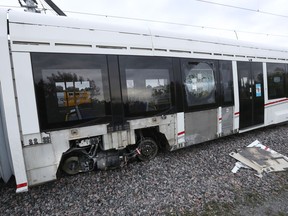
Critical safety issues remain with the trains on Ottawa’s Confederation Line that must be remedied to keep travellers safe and prevent derailments, according to the final report of Ottawa Light Rail Transit Public Inquiry released this week.
The inquiry examined two derailments in detail. The first occurred on Aug. 8, 2021 just east of the Tunney’s Pasture Station and involved an empty train. The second, six weeks later on Sept. 19, happened near Tremblay Station on a train carrying 12 passengers, one of whom happened to be the director of train maintenance. No one was injured in either incident.
Sign up to receive daily headline news from Ottawa Citizen, a division of Postmedia Network Inc.
Thanks for signing up!
A welcome email is on its way. If you don't see it, please check your junk folder.
The next issue of Ottawa Citizen Headline News will soon be in your inbox.
Human error was to blame for the second derailment: a worker failed to tighten the bolts on a gear box that had been removed for inspection, Justice William Hourigan wrote in his report. But the first was caused by problems in the “critical wheel/rail interface” between the train and the tracks. Although the trainmaker, Alstom, and Rideau Maintenance Group have been working to resolve that issue, a permanent fix isn’t in place.
“This is important, as it is a critical safety issue affecting the OLRT1 system if left unaddressed,” Hourigan wrote.
The first derailment was caused by a broken axle bearing assembly. Alstom said that failure was caused by vibration due to curves and uneven track and by how train operators are driving. Rideau Transit Group said the track wasn’t to blame, but the failure was caused by defects in the axle itself.
Alstom presented some short term fixes, including greasing the rails, lowering the speed limit at critical locations and modifying the profile of the train wheels to better withstand the forces at play. It even suggested completely regrinding the rails, a massive task that would make for a smoother ride but would shorten the life of the track.
“It is critical that the risk of future derailments be mitigated,” the inquiry report said. “While the City and RTG need to continue with the interim measures already in place, and any others that are deemed advisable as more becomes known about the root cause of this derailment and the wheel/rail interface more generally, it is clear that a more permanent solution needs to be found.”
That accident remains under investigation by the federal Transportation Safety Board.
In his report, Hourigan also recommended changes to maintenance practices to reduce the risk of another mishap like the Tremblay Station one, which caused significant damage to the system and shut down the LRT for weeks.
“At the time of the derailment, Alstom’s maintenance work was inconsistent and lacked sufficient quality control checks,” he wrote. “This human error might have been avoided with effective quality control measures.”
Twenty-two of the report’s 103 recommendations have to do with improving safety on the system. They include better training for operators so that they’re more aware and quick to report problems, that safety-critical tasks not be spread over more than one shift at the maintenance facility, that the province give legal protection to “whistleblowers” who come forward with concerns, and that an independent expert continue to monitor safety issues and remedial actions.
And continuing the over-arching theme of Hourigan’s report, he urges the parties involved to be transparent, accountable and to play nice.
“If RTG continues to be responsible for maintenance during the remainder of the maintenance term, RTG and the City, as well as RTM and Alstom Maintenance, should make efforts to repair their relationships and work together better for the greater good of the OLRT1 project,” he wrote.


